Silk Road Transportation
Maritime Route
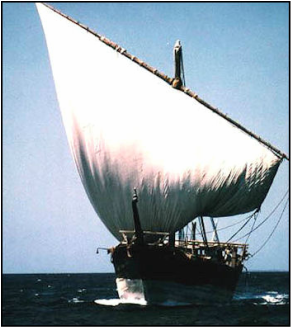 Dhow at sea.
Dhow at sea.
More silk and Silk Road goods reached the West via sea routes rather than by overland routes. The main Silk Road sea routes were between Indian ports like Barbaricon, Barygaza and Muziris and Middle Eastern ports such as Muscat, Sur, Kane and Aden on the Arabian Sea and Muza and Berenike on the Red Sea. From the Middle East goods were transported overland to the Mediterranean Sea and then Europe. From India goods flowed to and from Southeast Asia, the East Indies and China.
Small boats hugged the shore. Large boats sailed the seasonal monsoon winds, which carried boats eastward to India in July, August and September and westward from India to the Middle East in December, January and February. The largest teak-hull ships that plied these routes may have been 180 feet long and capable of carrying cargoes of 1,000 tons. Much of the trade on the Silk Road sea routes were carried out by Arab, Persian, and Indian ships, not by Chinese ships. These boats were called dhows.
Small boats hugged the shore. Large boats sailed the seasonal monsoon winds, which carried boats eastward to India in July, August and September and westward from India to the Middle East in December, January and February. The largest teak-hull ships that plied these routes may have been 180 feet long and capable of carrying cargoes of 1,000 tons. Much of the trade on the Silk Road sea routes were carried out by Arab, Persian, and Indian ships, not by Chinese ships. These boats were called dhows.
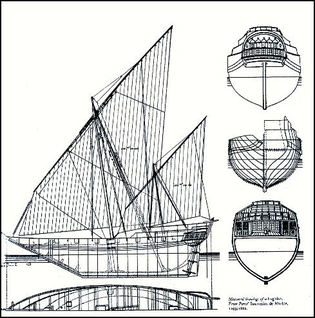 A dhow.
A dhow.
A dhow is a traditional type of sailing ship that was used extensively on the Maritime Silk Route. You can still find dhows working the coastal waters of China and India today. About twenty years ago, divers found a 9th century Arab dhow laden with 60,000 handmade ceramics and some pieces of gold and silver. Much of the cargo that the divers found was made up of cheap, mass-produced, Chinese-made bowls, known as Changsa bowls. The Changsa bowls were found placed in large storage jars. There were also ink pots, spices jars of various sizes, and household pitchers.
Dhow rigging
Many of the bowls were decorated with geometric patterns and designs related to the Koran. Those finds made it clear that the boat and its trade goods were intended for a Middle Eastern market. This implied that these Chinese-made objects were “made to order” for Middle Eastern customers. The discovery of such goods indicated that the boat was a part of the Maritime Silk Route.
Dhow rigging
Many of the bowls were decorated with geometric patterns and designs related to the Koran. Those finds made it clear that the boat and its trade goods were intended for a Middle Eastern market. This implied that these Chinese-made objects were “made to order” for Middle Eastern customers. The discovery of such goods indicated that the boat was a part of the Maritime Silk Route.
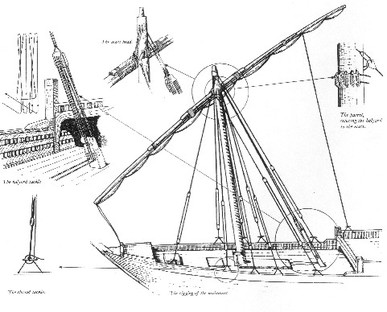 Dhow rigging.
Dhow rigging.
Dhows
A dhow is a type of sail boat that has been used by Arab sailors for over 2000 years in the the Persian Gulf, Arabian Sea, and Indian Ocean , on what may be the world’s oldest continually run commercial sailing route. The dhow that was discovered was just over 60 feet long. It was built of wood from Africa and India. It had a sharply angled prow (front-end) and stern (back-end), and it was fitted with square sails and made of planks sewn together with coconut husk fibers.
The first dhows were simple dugouts with teak planks sewn to their sides. Over time larger vessels were developed that used a keel on which the planks were sewn. Dhows usually have one or two masts. Most large dhow have two masts that support sails as wide as the ship is long. With the large sails and a monsoon wind behind them, it’s said that the dhows could cover over 100 miles in a day. Compared with foot traffic on the Overland Route, it would have been like traveling aboard a rocket ship.
A dhow is a type of sail boat that has been used by Arab sailors for over 2000 years in the the Persian Gulf, Arabian Sea, and Indian Ocean , on what may be the world’s oldest continually run commercial sailing route. The dhow that was discovered was just over 60 feet long. It was built of wood from Africa and India. It had a sharply angled prow (front-end) and stern (back-end), and it was fitted with square sails and made of planks sewn together with coconut husk fibers.
The first dhows were simple dugouts with teak planks sewn to their sides. Over time larger vessels were developed that used a keel on which the planks were sewn. Dhows usually have one or two masts. Most large dhow have two masts that support sails as wide as the ship is long. With the large sails and a monsoon wind behind them, it’s said that the dhows could cover over 100 miles in a day. Compared with foot traffic on the Overland Route, it would have been like traveling aboard a rocket ship.
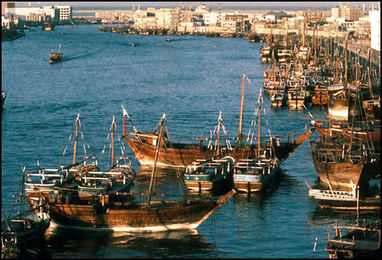 Dhows at port.
Dhows at port.
Dhow Materials and Features
Dhows are still used today, and many are still constructed the way they were during the Silk Road era. During that time, large seaworthy dhows had teak hulls that were reinforced for strength by the use of timber ribs. They were held together with a natural paste and plugged with cotton strips soaked in fish oil and caulked with whale or shark oil.
The preferred wood for the ribs and keel was teak or a similar wood. The keels were usually made from a giant log from a single tree. Teak and coconut-palm wood have been favored for masts and spars. Teak has been prized in shipbuilding because it was strong and resistant to sea worms.
Dhows are still used today, and many are still constructed the way they were during the Silk Road era. During that time, large seaworthy dhows had teak hulls that were reinforced for strength by the use of timber ribs. They were held together with a natural paste and plugged with cotton strips soaked in fish oil and caulked with whale or shark oil.
The preferred wood for the ribs and keel was teak or a similar wood. The keels were usually made from a giant log from a single tree. Teak and coconut-palm wood have been favored for masts and spars. Teak has been prized in shipbuilding because it was strong and resistant to sea worms.
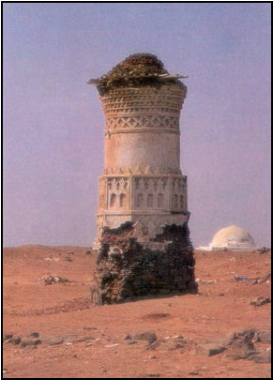 Remains of the lighthouse at Mocha.
Remains of the lighthouse at Mocha.
Dhows were sewn together. The timbers were lashed together with ropes made of coconut fibers rolled and twisted by hand. No nails were used. There was an ancient belief that the ocean’s floor was a giant magnet that would suck out nails.
Coconut ropes were used for the dhow’s rigging. The ropes were made from the husks of coconuts rotted in sea water (not fresh water), pounded with wooden mallets (not iron hammers which weaken the fiber), and spun by hand.
The sails on dhows were made from woven palm leaves, coconut fiber, reeds, or cotton. Ships with lateen, triangular, sails are faster and more maneuverable than ships with square-rigged sails. Lateen sails copied from dhows were eventually used on European ships during the age of exploration.
The bathroom on a dhow was often a “balcony” slung over the stern or a hole in the deck in the back of the boat. Showers consisted of seawater drawn with a bucket and dumped over oneself.
Dhow building passed down from father to son and ships were made with no blueprints except for what was in the head of the builder. Timbers were shaped with hand tools, and experienced shipbuilders could construct a craft with no way of making sure that the pieces were plumb or level except for what they measured with their eyes.
Large dhows had as many as 20,000 holes for the coconut rope fasteners bored into them by hand with a bow drill. The rope was threaded by special craftsmen and the holes were plugged on the inside with coconut husks or dowels. On the outside, they were sealed with a waterproof mix of lime and tree gum. The coconut rope was swabbed with vegetable oil to preserve it.
Coconut ropes were used for the dhow’s rigging. The ropes were made from the husks of coconuts rotted in sea water (not fresh water), pounded with wooden mallets (not iron hammers which weaken the fiber), and spun by hand.
The sails on dhows were made from woven palm leaves, coconut fiber, reeds, or cotton. Ships with lateen, triangular, sails are faster and more maneuverable than ships with square-rigged sails. Lateen sails copied from dhows were eventually used on European ships during the age of exploration.
The bathroom on a dhow was often a “balcony” slung over the stern or a hole in the deck in the back of the boat. Showers consisted of seawater drawn with a bucket and dumped over oneself.
Dhow building passed down from father to son and ships were made with no blueprints except for what was in the head of the builder. Timbers were shaped with hand tools, and experienced shipbuilders could construct a craft with no way of making sure that the pieces were plumb or level except for what they measured with their eyes.
Large dhows had as many as 20,000 holes for the coconut rope fasteners bored into them by hand with a bow drill. The rope was threaded by special craftsmen and the holes were plugged on the inside with coconut husks or dowels. On the outside, they were sealed with a waterproof mix of lime and tree gum. The coconut rope was swabbed with vegetable oil to preserve it.
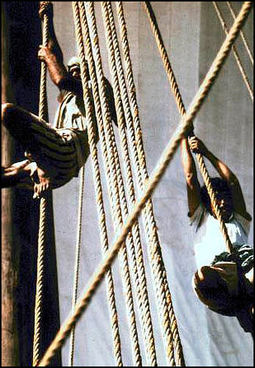
Dhow Crews
Traditionally a dhow was captained by a ship master with a crew of ten shipmates, most of whom dressed in turbans or head clothes, sarongs, and robes. Most were Muslims who dutifully bowed and directed their prayers towards Mecca five times a day.
Dhow crews have traditionally had little sense of time and spent much of their time lying around chatting, dozing, making Arabesque music, chewing qat, making and drinking tea and making baskets. Passengers would have traditionally been asked to pay a goat for each voyage.
If there was work to do the crew would suddenly jump and do it. The crew followed orders of the ship master instantly and often chanted and sang as they did their chores. Dhow captains made sure their crews were from different villages so they didn’t gang up on him.
One writer described a dhow crew this way: “They settled easily into the rhythm of shipboard life. They chatted, sang traditional songs, rigged fishing lines in our wake, and dozed. They could sleep anywhere, stretched out on deck with their turbans unwound and draped over their faces for shade. Yet whenever there was work to be done, they laid into the job with zest.”
Dhow Supplies
Though many dhow captains could not read a map and navigated routes from memory, dhows traditionally carried only a pair of compasses and a kamal, a navigation devise that could determine latitude based on the height of the North Star above the horizon.
Food aboard ship included unleavened bread, rice, goat stew, and ghee (clarified butter). Fresh fish were caught with lines that hung off the boat.
Dhow Cargoes
During the Silk Road era, dhows made it as far as China and Indonesia. They traded linen, cotton, woolen clothes, metalwork and iron ore from the Middle East for silks, camphor, musk and spices from Asia. Today, dhows are often used to transport tourists or to ferry people over short distances.
Traditionally a dhow was captained by a ship master with a crew of ten shipmates, most of whom dressed in turbans or head clothes, sarongs, and robes. Most were Muslims who dutifully bowed and directed their prayers towards Mecca five times a day.
Dhow crews have traditionally had little sense of time and spent much of their time lying around chatting, dozing, making Arabesque music, chewing qat, making and drinking tea and making baskets. Passengers would have traditionally been asked to pay a goat for each voyage.
If there was work to do the crew would suddenly jump and do it. The crew followed orders of the ship master instantly and often chanted and sang as they did their chores. Dhow captains made sure their crews were from different villages so they didn’t gang up on him.
One writer described a dhow crew this way: “They settled easily into the rhythm of shipboard life. They chatted, sang traditional songs, rigged fishing lines in our wake, and dozed. They could sleep anywhere, stretched out on deck with their turbans unwound and draped over their faces for shade. Yet whenever there was work to be done, they laid into the job with zest.”
Dhow Supplies
Though many dhow captains could not read a map and navigated routes from memory, dhows traditionally carried only a pair of compasses and a kamal, a navigation devise that could determine latitude based on the height of the North Star above the horizon.
Food aboard ship included unleavened bread, rice, goat stew, and ghee (clarified butter). Fresh fish were caught with lines that hung off the boat.
Dhow Cargoes
During the Silk Road era, dhows made it as far as China and Indonesia. They traded linen, cotton, woolen clothes, metalwork and iron ore from the Middle East for silks, camphor, musk and spices from Asia. Today, dhows are often used to transport tourists or to ferry people over short distances.
